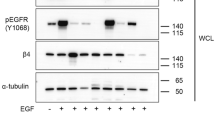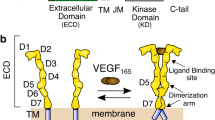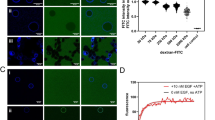Abstract
In the present study, we examined EGF-induced internalization, degradation and trafficking of the epidermal growth factor receptor (EGFR) mutated at serines 1046, 1047, 1057 and 1142 located in its cytoplasmic carboxy-terminal region. We found the serine-mutated EGFR to be inhibited in EGF-induced internalization and degradation in NIH3T3 cells. We therefore tested the hypothesis that these mutations affect ligand-induced c-Cbl association with the receptor, leading to inhibited receptor ubiquitination. EGF was unable to induce ubiquitination of the serine-mutated EGFR, yet EGF-induced phosphorylation of the c-Cbl-binding site at tyrosine 1045, and c-Cbl-EGFR association, was unaffected. To compare the relevance of these serine residues with tyrosine 1045 in their regulation of c-Cbl binding and receptor ubiquitination, we analysed an EGFR mutated at tyrosine 1045 (Y1045F). EGF-induced c-Cbl-EGFR binding was partially inhibited, and receptor ubiquitination was abrogated in cells expressing Y1045F-EGFR. In contrast, ligand-induced internalization and degradation of the Y1045F mutant was similar to that of wild-type EGFR. Together, our data indicate that the serine residues and tyrosine 1045 are essential for EGF-induced receptor ubiquitination, but only the serine residues are critical for EGFR internalization and degradation.
This is a preview of subscription content, access via your institution
Access options
Subscribe to this journal
Receive 50 print issues and online access
$259.00 per year
only $5.18 per issue
Buy this article
- Purchase on Springer Link
- Instant access to full article PDF
Prices may be subject to local taxes which are calculated during checkout








Similar content being viewed by others
References
Bao J, Alroy I, Waterman H, Schejter ED, Brodie C, Gruenberg J and Yarden Y . (2000). J. Biol. Chem., 275, 26178–26186.
Carpenter G . (2000). Bioessays, 22, 697–707.
Chen Z, Hagler J, Palombella VJ, Melandri F, Scherer D, Ballard D and Maniatis T . (1995). Genes Dev., 9, 1586–1597.
Clague MJ and Urbe S . (2001). J. Cell Sci., 114, 3075–3081.
Countaway JL, McQuilkin P, Girones N and Davis RJ . (1990). J. Biol. Chem., 265, 3407–3416.
Countaway JL, Nairn AC and Davis RJ . (1992). J. Biol. Chem., 267, 1129–1140.
Courbard JR, Fiore F, Adelaide J, Borg JP, Bimbaum D and Ollendorff V . (2002). J. Biol. Chem., 277, 45267–45275.
Di Guglielmo GM, Baass PC, Ou WJ, Posner BI and Bergeron JJ . (1994). EMBO J., 13, 4269–4277.
Eccles SA, Modjtahedi H, Box G, Court W, Sandle J and Dean CJ . (1994). Invasion Metas., 14, 337–348.
Feinmesser RL, Wicks SJ, Taverner CJ and Chantry A . (1999). J. Biol. Chem., 274, 16168–16173.
Felder S, Miller K, Moehren G, Ullrich A, Schlessinger J and Hopkins CR . (1990). Cell, 61, 623–634.
Franklin WA, Veve R, Hirsch FR, Helfrich BA and Bunn Jr PA . (2002). Semin. Oncol., 29, 3–14.
Galcheva-Gargova Z, Theroux SJ and Davis RJ . (1995). Oncogene, 11, 2649–2655.
Covers R, van Kerkhof P, Schwartz AL and Strous GJ . (1998). J. Biol. Chem., 273, 16426–16433.
Haugh JM, Huang AC, Wiley HS, Wells A and Lauffenburger DA . (1999). J. Biol. Chem., 274, 34350–34360.
Helin K and Beguinot L . (1991). J. Biol. Chem., 266, 8363–8368.
Joazeiro CA, Wing SS, Huang H, Leverson JD, Hunter T and Liu YC . (1999). Science, 286, 309–312.
Kashles O, Szapary D, Bellot F, Ullrich A, Schlessinger J and Schmidt A . (1988). Proc. Natl. Acad. Sci. USA, 85, 9567–9571.
Lamaze C and Schmid SL . (1995). J. Cell Biol., 129, 47–54.
Levkowitz G, Oved S, Klapper LN, Harari D, Lavi S, Sela M and Yarden Y . (2000). J. Biol. Chem., 275, 35532–35539.
Levkowitz G, Waterman H, Ettenberg SA, Katz M, Tsygankov AY, Alroy I, Lavi S, Iwai K, Reiss Y, Ciechanover A, Lipkowitz S and Yarden Y . (1999). Mol. Cell., 4, 1029–1040.
Levkowitz G, Waterman H, Zamir E, Kam Z, Oved S, Langdon WY, Beguinot L and Geiger Band Yarden Y . (1998). Genes Dev., 12, 3663–3674.
Longva KE, Blystad FD, Stang E, Larsen AM, Johannessen LE and Madshus IH . (2002). J. Cell Biol., 156, 843–854.
Lund KA, Lazar CS, Chen WS, Walsh BJ, Welsh JB, Herbst JJ, Walton GM, Rosenfeld MG, Gill GN and Wiley HS . (1990). J. Biol. Chem., 265, 20517–20523.
Meisner H, Conway BR, Hartley D and Czech MP . (1995). Mol. Cell. Biol., 15, 3571–3578.
Meisner H and Czech MP . (1995). J. Biol. Chem., 270, 25332–25335.
Oksvold MP, Skarpen E, Lindeman B, Roos N and Huitfeldt HS . (2000). J. Histochem. Cytochem., 48, 21–33.
Orford K, Crockett C, Jensen JP, Weissman AM and Byers SW . (1997). J. Biol. Chem., 272, 24735–24738.
Schlessinger J . (2002). Cell, 110, 669–672.
Sorkin A, Helin K, Waters CM, Carpenter G and Beguinot L . (1992). J. Biol. Chem., 267, 8672–8678.
Soubeyran P, Kowanetz K, Szymkiewicz I, Langdon WY and Dikic I . (2002). Nature, 416, 183–187.
Tebar F, Villalonga P, Sorkina T, Agell N, Sorkin A and Enrich C . (2002). Mol. Biol. Cell, 13, 2057–2068.
Theroux SJ, Taglienti-Sian C, Nair N, Countaway JL, Robinson HL and Davis RJ . (1992). J. Biol. Chem., 267, 7967–7970.
Thien CBF and Langdon WY . (1997a). Oncogene, 14, 2239–2249.
Thien CBF and Langdon WY . (1997b). Oncogene, 15, 2909–2919.
Thien CBF and Langdon WY . (2001). Nat. Rev. Mol. Cell. Biol., 2, 294–307.
Thien CBF, Walker F and Langdon WY . (2001). Mol. Cell, 7, 355–365.
Waterman H, Katz M, Rubin C, Shtiegman K, Lavi S, Elson A, Jovin T and Yarden Y . (2002). EMBO J., 21, 303–313.
Waterman H, Levkowitz G, Alroy I and Yarden Y . (1999). J. Biol. Chem., 274, 22151–22154.
Wiley HS, Herbst JJ, Walsh BJ, Lauffenburger DA, Rosenfeld MG and Gill GN . (1991). J. Biol. Chem., 266, 11083–11094.
Yarden Y and Schlessinger J . (1987). Biochemistry, 26, 1443–1451.
Acknowledgements
We thank Helga Grøsvik for excellent technical assistance, and Dr Brian Druker for the generous provision of the 4G10 antibody. This work was supported by grants from the Research Council of Norway, the Norwegian Cancer Society, and NH&MRC (Canberra).
Author information
Authors and Affiliations
Corresponding author
Rights and permissions
About this article
Cite this article
Oksvold, M., Thien, C., Widerberg, J. et al. Serine mutations that abrogate ligand-induced ubiquitination and internalization of the EGF receptor do not affect c-Cbl association with the receptor. Oncogene 22, 8509–8518 (2003). https://doi.org/10.1038/sj.onc.1207117
Received:
Revised:
Accepted:
Published:
Issue Date:
DOI: https://doi.org/10.1038/sj.onc.1207117
Keywords
This article is cited by
-
Non-metabolic role of UCK2 links EGFR-AKT pathway activation to metastasis enhancement in hepatocellular carcinoma
Oncogenesis (2020)
-
Progesterone receptor membrane component 1 promotes the growth of breast cancers by altering the phosphoproteome and augmenting EGFR/PI3K/AKT signalling
British Journal of Cancer (2020)
-
MARQUIS: A multiplex method for absolute quantification of peptides and posttranslational modifications
Nature Communications (2015)
-
Tetrathiomolybdate mediates cisplatin-induced p38 signaling and EGFR degradation and enhances response to cisplatin therapy in gynecologic cancers
Scientific Reports (2015)
-
RSK2 regulates endocytosis of FGF receptor 1 by phosphorylation on serine 789
Oncogene (2014)



